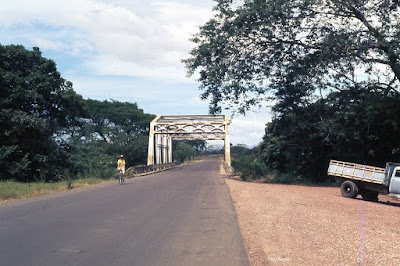 |
| Native to the rainforest of Costa Rica, heliconia or lobster claw (genus Heliconia, heliconia family, Heliconiaceae) |
I’d been back to some places (1970s, 1986, 2013) but this tour hit many of the places I went in 1972 and had a focus of Costa Rican conservation.
In 1972 North American biologists had been running courses for graduate students in Costa Rica for 7 years. They thought it an effective way to teach about climates and ecosystems not found in the continental United States and they hoped some students would consequently do research in the tropics during their careers. Costa Rica was chosen because so many of the major ecosystems of the American tropics—Atlantic and Pacific lowland rainforests (although some animals are found in both, the mountains that separate them have made them largely different), up mountains on both sides to paramo above timberline (about paramo). In addition the tropical dry forest of the west coast of Central America ends in northern Costa Rica. (Read more; See lifezone map (half way down page) link) All of this in an area the size of West Virginia, 41st in size of the U.S. states, making visiting multiple ecosystems relatively easy. And, from well before 1972, Costa Rica has had a stable government.
I took a tropical ecology course (Organization for Tropical Studies, OTS) in 1972 and then went back to Costa Rica to work on my Ph.D. thesis, at the OTS Palo Verde Field Station, in the middle of a working cattle ranch. Cows for hamburger in the U.S. were a major export.
 |
| Pasture around the Palo Verde Field Station, with cows Costa Rica 1973 |
It was clear that Costa Rica needed development, from phones to roads to, especially, higher income for families.
 |
| InterAmerican Highway, 1973 |
But development in Central America (and North America but longer ago) meant clearing the land, cutting the trees, killing native animals. And in the 1970s and 1980s, much of Costa Rica's forest was cut for cattle or crops.
Going back after 47 years with 1972 in mind, wow! has Costa Rica changed. Because beginning in the 70's, they started preserving forests. And reforesting.
In 1972 Costa Rica had two national parks. Today it has 28, plus many Forest Reserves and privately owned forest preserves making appoximately 27% of the country protected from deforestation. In addition, less formal reforestation has them at 58% forest cover, a quite dramatic recovery from the low of 21% forest cover in 1987.
The field station I worked on is now in the middle of a national park that is recognized as a RAMSAR Wetland of International Importance. (Palo Verde National Park link)
 |
| Palo Verde National Park, Costa Rica 2019 The green in the distance is the big marsh the wildfowl use |
It hasn’t been easy, but they they have not done that at the expense of local people. They built on their natural beauty and diversity to be not just a place to sit on the beach, but a destination for ecotourism: to see magnificent birds, exotic animals, oversized butterflies, bizarre plants. Ecotourism, such as the tour I took, values the native organisms and employs guides, drivers, hotel and restaurant staff, national park/private reserve staff, souvenir makers…the list goes on.
 |
| InterAmerican Highway, 2019; about the same spot as the photo above although a different angle |
The roads have too many cars but they are much, much better than in 1972. All the hotels had wifi, generally with good connections in the rooms. I bought coffee in a supermarkets that seemed only to differ from mine in Colorado by language.
 |
| anhinga, Costa Rica |
I saw scarlet macaws, army ants, and coati mundis on day hikes from comfortable lodgings. With a guide I saw animals I would have missed on my own, sloths for example. But also, not being hunted makes animals more numerous and less shy: it is easier to get a good view.
I have a plant bias: plants are easier to see in Costa Rica too. Deforestation is selective: the valuable woods go first. Costa Rica has been replanting and letting natural reforestation occur, so trees that were hard to find are growing up. A mature tropical forest has lots of really big trees like pillars amid an array of plants of smaller size. It takes centuries to reach that combination after cutting but remnants remain and the rest is maturing.
 |
| Big iguana on branch right above the swimming pool at the Selva Verde Lodge |
 |
| Really big tree, Costa Rica 2019 |
I feel lucky to have been to Costa Rica so long ago and to have been able to return to find it cherishing its natural heritage. Too often you can't return to a place visited 40 years ago--it has been transformed into something quite different. Some beaches I loved have developed to the point I can't afford to stay there (well, they were that glorious) but the wildlife and the forest that the wild animals require has been wonderfully protected. You can hike off into the forest for strenuous adventures, as I did as a working ecologist, or wander slowly down a trail from a comfortable lodge, as I like these days. Both ways you see amazing plants and animals. How wonderful that Costa Rica still accomodates both approaches and has so preserved its natural diversity!
Comments and corrections welcome.
Read more
Case Studies in Environmental Science: Costa Rica link
Rainforests: mongabay link
Comments and corrections welcome.
Read more
Case Studies in Environmental Science: Costa Rica link
Rainforests: mongabay link
Kathy Keeler, A Wandering Botanist
More at awanderingbotanist.com


Good
ReplyDelete